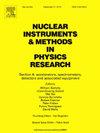通过蒙特卡洛模拟优化 PRESET 卫星电子能谱仪望远镜的几何形状
IF 1.5
3区 物理与天体物理
Q3 INSTRUMENTS & INSTRUMENTATION
Nuclear Instruments & Methods in Physics Research Section A-accelerators Spectrometers Detectors and Associated Equipment
Pub Date : 2024-10-09
DOI:10.1016/j.nima.2024.169954
引用次数: 0
摘要
搭载在 PRESET 卫星任务上的电子分光计望远镜(EST)旨在测量范艾伦外带中 0.3-4 兆电子伏特电子的俯仰角分布。PRESET卫星计划于2026年第二季度发射进入太阳同步低地球轨道。我们将进行全面的蒙特卡罗模拟,以优化 EST 仪器的设计和响应。EST由一堆硅带探测器和一个准直器组成,用于测量与俯仰角相关的电子能谱,目标角度分辨率为6°,同时拒绝质子、重离子和伽马探测事件。利用 Geant4 代码对各种准直器设计和探测器堆叠配置进行了研究,以推导出最佳设计和配置。为了验证 Geant4 模拟的有效性,使用四个硅探测器堆叠建立了一个基准测试光谱仪,发现对于来自 90Sr/90Y 源的β光谱,测量响应和模拟响应之间具有良好的一致性。通过调整总长度、孔径大小、视口数量和准直器材料,对准直器设计进行了优化。通过改变孔径大小和视口数量,确定了最佳孔径大小和视口数量,并选择了符合角度分辨率和几何因子要求的最佳情况。此外,为了解决典型针孔准直器中前端位置敏感探测器利用率不足的问题,还采用了两个轴线倾斜的偏置准直器。通过改变硅探测器的数量和每个探测器的厚度,进行了广泛的模拟,以优化硅探测器堆栈的配置。结果发现,前探测器的最佳厚度为 140 微米,这可以最大限度地减少质子探测事件引起的扰动计数。至于其他探测器,则选择了四个 1.5 毫米厚的探测器堆叠,以便在系统复杂度可以承受的情况下实现对低能电子的良好灵敏度。为 EST 最佳设计模拟的角度响应显示分辨率为 5.5°,略高于目标分辨率 6°。针对各向同性电子和质子场模拟的最终设计响应矩阵显示出较高的几何系数,预计可在捕获区内产生 230 cps 的平均电子计数率,除 1.0-1.1 MeV 质子的轻微污染外,质子对电子能谱的污染可忽略不计。本文章由计算机程序翻译,如有差异,请以英文原文为准。
Optimization of the Electron Spectrometer Telescope geometry for the PRESET satellite through Monte Carlo simulation
The Electron Spectrometer Telescope (EST) aboard the PRESET satellite mission aims to measure the pitch angle distribution of 0.3–4 MeV electrons in the outer Van Allen belts. The PRESET satellite is planned to launch into a sun-synchronous low Earth orbit in Q2, 2026. We present comprehensive Monte Carlo simulations to optimize the design and response of the EST instrument. The EST consists of a stack of silicon strip detectors and a collimator to take pitch-angle dependent electron spectral measurements with a target angular resolution of 6° while rejecting the proton, heavy ion and gamma detection events. Various collimator designs and detector stacking configurations are investigated using the Geant4 code to deduce an optimal design and configuration. For validation of the Geant4 simulations, a benchmark test spectrometer was set up using a stack of four silicon detectors and a good agreement between the measured and simulated responses was found for a beta spectrum from a 90Sr/90Y source. The collimator design was optimized by adjusting total length, aperture size, number of view-ports and collimator materials. The optimum aperture size and the number of view-ports were determined by varying them and selecting the best cases that meet the angular resolution and the geometric factor requirements. Moreover, to address the under-utilization of the front position-sensitive detector encountered in a typical pin-hole collimator, two offset collimators with tilted axes were employed. Extensive simulations were carried out by varying the number of silicon detectors and the thickness of each detector to optimize the configuration of the silicon detector stack. An optimum thickness of the front detector was found to be 140 µm, which can minimize the perturbation counts caused by the proton detection events. For the other detectors, a stack of four 1.5 mm thick detectors was chosen to achieve a good sensitivity to low energy electrons at a tolerable complexity of the system. The angular response simulated for the optimum design of the EST showed a resolution of 5.5°, which is slightly better than the target resolution of 6°. The response matrices of the final design simulated for isotropic electron and proton fields showed a high geometric factor, which is expected to produce an average electron counting rate of 230 cps within the trapped region with a negligible contamination of the electron spectrum by protons except for a mild contamination by the 1.0–1.1 MeV protons.
求助全文
通过发布文献求助,成功后即可免费获取论文全文。
去求助
来源期刊
CiteScore
3.20
自引率
21.40%
发文量
787
审稿时长
1 months
期刊介绍:
Section A of Nuclear Instruments and Methods in Physics Research publishes papers on design, manufacturing and performance of scientific instruments with an emphasis on large scale facilities. This includes the development of particle accelerators, ion sources, beam transport systems and target arrangements as well as the use of secondary phenomena such as synchrotron radiation and free electron lasers. It also includes all types of instrumentation for the detection and spectrometry of radiations from high energy processes and nuclear decays, as well as instrumentation for experiments at nuclear reactors. Specialized electronics for nuclear and other types of spectrometry as well as computerization of measurements and control systems in this area also find their place in the A section.
Theoretical as well as experimental papers are accepted.

 求助内容:
求助内容: 应助结果提醒方式:
应助结果提醒方式:


